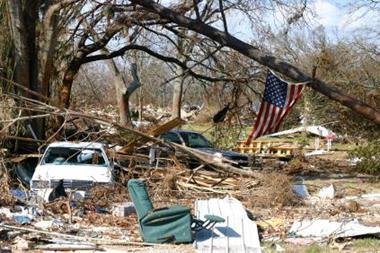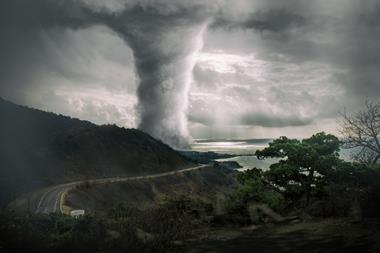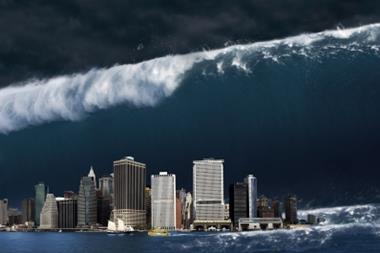For curiosity or betting or for insurance and risk management purposes, we often require estimates of how ‘extreme' the values might be over a given time period. By John Birkenhead
On 9 September 2007, the Jamaican sprinter Asafa Powell set a new world record of 9.74 seconds for the men's 100m race; this record has moved by just 0.21 seconds since 1968, as Table 1 shows.
How low can this record go? What is the limit of human endurance over 100m? And what has this got in common with extreme value theory and catastrophe risk management?
By definition, extreme values are large and scarce. Typical examples are:
* Flooding - an extreme volume of water in a given location
* Earthquakes - the release of extreme amounts of energy from within the earth
* Industrial component failure leading to extreme pressures, temperatures, explosions, etc
* Stock market crash - extreme downward price movements
World record race times or, equivalently, maximal human speeds over a given distance, are also examples of extreme values. The common factor is that, for curiosity or betting on the fastest race times or for insurance and risk management purposes, (when it comes to flooding, earthquake, or explosions, etc), we often require estimates of how ‘extreme' the values might be over a given time period. For example, how bad would a 1 in 200 year flood event be?
Human world speed records or catastrophic insured events are, therefore, just more extreme values of events which have happened in the past. Extreme value theory (EVT) provides a mathematical framework for estimating the probabilities of these more extreme future events. This article looks briefly at the theory of EVT and its practical implications for the management of catastrophe risks.
EVT - what is it all about?
The generalised EVT model is shown in Table 2.
There is no proven empirical or physical basis to support this model; it uses mathematical assumptions about the behaviour of very large numbers of events to extrapolate to rarer, as yet unseen, events.
A common way of recording extreme value data is just to show the maximum value in any given year, as in Table 1. There may, however, have been other race times that were more extreme than the fastest times in other years. For example, a competitor may have run 100m in 9.80 seconds in 2007. This would have been a record in 1996, but it was not in 2007, and so does not appear in Table 1. In other words, data recorded in this way will be very sparse, with much useful information ‘wasted'.
Using data for the top n race times in each calendar year is much more complicated mathematically, but the fundamental result still holds: the distribution of the nth fastest race time in a given year is still given by the result in Table 2, for very large samples of data.
Threshold values and return periods
A more useful way of analysing extreme values is to ask the question: "What is the probability that a future extreme value will be more than a desired threshold value of X?" Perhaps X is the level of retention for an insured, or the maximum aggregation of risk an insurer is prepared to take in a high risk location, such as an earthquake zone.
For example, an underwriter may require to test the assumption that the estimated probability of an earthquake measured at more than 7.0 on the Richter scale is, say, less than 0.1%. Or, put another way the estimated return period of such an earthquake is no more than 1 in 1,000 years (100 % /0.1 %). Table 3 shows world wide earthquake data since 2000.
Although the raw data in Table 3 suggest a probability of only 0.05% for earthquakes of magnitude 7.0+, this is just the empirical or observed frequency and can be calculated just using the number of observed earthquakes at that level as a proportion of the total number of earthquakes.
What EVT does is to use information on the number and size of all 217,000 occurrences (i.e. a very large sample size) to extrapolate to the higher values.
Management of extreme value risk
Natural catastrophes, such as earthquakes and windstorms, are generally thought to be uncontrollable; thus, if an earthquake of magnitude 7.0+ starts, it cannot be stopped. Pre-loss risk management, therefore, lies in the development of early warning systems, such as geophysical measurements of small initial movements of the earth's crust. The critical task is to define threshold levels of observed movement at which risk warnings are issued to the public and avoid false positives and avoid raising the alarm unnecessarily. Additionally, building structures can be strengthened in advance to withstand large earthquakes and, for flooding events, defences can be built in advance. The Association of British Insurers, for example, argues that the government allocation for flood defences, announced after the floods of summer 2007, is inadequate. These floods are now estimated to have been a 1 in 200 year flood event.
Similarly, the failure of machinery components can cause extremes of pressure and temperature that result in explosions, fires and escapes of pollution. It is, therefore, critical to monitor ‘vital signs', such as temperature, vibration, oil quality, etc., which may signal the increased likelihood of impending disaster.
In terms of EVT, these maintenance decisions can be formulated as:
Carry out preventative maintenance at the first moment when, for fixed x, the probability of an extreme catastrophic failure happening before x exceeds a certain predetermined value.
For example, if the probability of an extreme event before month 12 is 0.1%, before month 24 is 1.0% and before month 36 is 5%, the maintenance decision might be an acceptable risk tolerance of 0.5%, implying that six monthly maintenance intervals are the balance between excessive maintenance costs and excessive catastrophic risk potential.
Post-loss mitigation of extreme value events includes the usual areas of minimising human casualties, such as ensuring access to emergency services, and facilitating the return to the pre-loss state, but on a catastrophic scale where the availability of desired items can be scarce or non-existent.
Insurance of extreme value risk
Insurers are risk takers, charging premiums to cover unknown, but potentially very large extreme future events. They are ultimately in business to make a profit. Although the law does not set maximum or minimum levels of premium, in practice premiums have a floor set by the need to maintain minimum levels of capital. In the United Kingdom, the Financial Services Authority (FSA) sets minimum levels of capital that each insurer must hold to allow it to continue trading. Current minimum levels are based on 99.5th percentiles, or put it another way, an insurer needs to be able to demenstrate sufficiency of capital in the event of a 1 in 200 year event (joint asset and liability) over the next 12 months. This is precisely the output of EVT modelling.
Thus, extreme values are of immense interest to insurers; they are particularly interested in what insureds will do to minimise the post-event damage, and, hence, the amount claimed.
Insurance vs betting
The legal differences between insurance and betting are well known, so we will focus on some practical differences. One key practical difference is that it is possible to place single bets several years in advance. Table 4 shows an example of currently available long term bets.
The question then is: Why can I not insure against earthquakes in the year 2012? Although multi-year policies are sometimes available, they rarely cover events so far into the future. They also require a multi-year policy (multiple ‘bets'), meaning the coverage for 2012 will be combined with coverage for 2008 - 2011 as well. You cannot just insure against earthquake damage in the year 2012 alone, five years in advance.
Most importantly, this is because insurance involves very large sums at risk, and a large earthquake risk could easily be spread among as many as 50 insurers and reinsurers who have to price at the time, depending upon their capital positions and the current state of the risk. If a bookmaker receives a large bet on a long shot, he can easily lay off the bet almost instantly by placing a similar bet anonymously with another bookmaker.
Furthermore, why can I not obtain an instant price for, say, earthquake cover immediately after an earthquake has happened? In the betting markets, it is possible to place bets ‘in-running'. For example, once a football match has started, the odds change almost instantaneously throughout the match as new information, like goals scored, emerges, and punters can bet (almost) in real-time. Since there are far too many changing items of information from all the football matches on a given day, bookmakers use statistical models to set the new odds instantly. If the odds are set incorrectly, they can be adjusted immediately.
Insurers cannot realistically operate an in-running pricing service; it takes weeks, perhaps months, for the full cost of an earthquake to be assessed. Even when this assessment has barely started, insurance and reinsurance buyers will be looking for a guide as to the impact on their renewals. Since such large risks are spread across many insurers and reinsurers, it is a long process for each insurer to re-assess its own risk profile, exposures and catastrophe models - not forgetting any increased capital requirements from the FSA!
Summary
So, what is the future for human speed records and, more importantly, for the insurance and risk management of extreme events? Table 5 shows the current world record times for a number of events and the estimated ultimate world records, based on EVT applied to many years of athletics data. These estimates tell us what, in principle, is possible in the near future.
Global catastrophes keep on getting bigger. Insured values rise inexorably. Extreme values are here to stay. Though supported by mathematical argument for very large samples, EVT is still based on unverifiable assumptions. We cannot predict catastrophic events, but at least EVT can help us to estimate their impact and plan risk management actions accordingly.
Postscript
John Birkenhead is an independent consulting actuary with almost 20 years' experience of commercial insurance matters.
Email: johnbirkenhead@btinternet.com
Website: www.johnbirkenhead.net.




















No comments yet